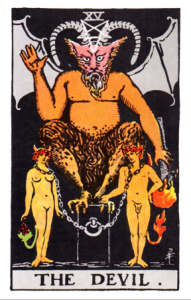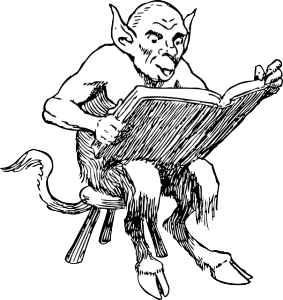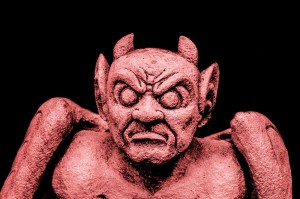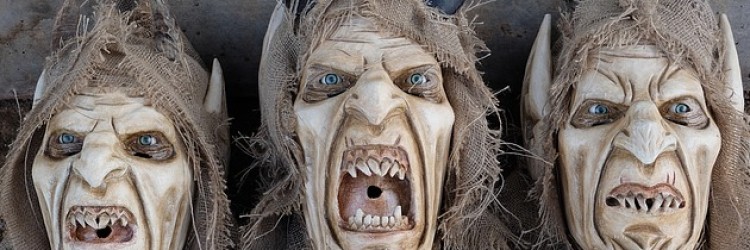“The Devil” card showing up in a Tarot reading shocks people. We have been taught since childhood that the Devil, or Satan, is God’s and humanity’s greatest enemy, evil incarnate, tempter of Adam and Eve. And ugly, too. The Devil in the Rider-Waite Tarot card is pictured with a ram’s horns, a goat’s legs, the wings of a bat, and a raptor’s claws. This unholy creature, bearded and grimacing, perches on a black rectangle. Chained to it by their necks are a naked man and woman, each with horns and tails. The Devil holds a flaming torch.
We’re all familiar with this image of the Devil. It’s the devil we know.

First, calm down. As with all images on Tarot cards, the Devil’s image is symbolic, not literal.
When a Knight of Cups shows up in your future, it doesn’t mean a real knight in real armor. It means a nice guy. If the Devil shows up in your future, it doesn’t mean the Devil will grab you, steal your soul, and roast you.
For those who believe there’s a devil because the Bible mentions them, our inner picture of the Devil, with pointed tail and pitchfork, doesn’t come from the Bible. It comes from Europe in the Middle Ages. And the story of Lucifer, the angel who went bad and fell from Heaven, famously told in Isaiah 14:12-17, refers not to an angel but to a man, the pagan king of Babylon who enslaved the Israelites. Read that whole passage, starting with Isaiah 14:3 (NIV):
On the day the Lord gives you relief from your suffering and turmoil and from the harsh labor forced on you, you will take up this taunt against the king of Babylon:
How the oppressor has come to an end!
Isaiah 14:12-17 is part of the taunt against the king. It ends:
Those who see you stare at you, they ponder your fate: “Is this the man who shook the earth and made kingdoms tremble, the man who made the world a wilderness, who overthrew its cities and would not let his captives go home?”
The name “Lucifer” that many of us know is from a Latin translation of the Bible. It has been dropped and replaced with its true, more careful translation from the original Hebrew: “Son of the Dawn,” or “Morning Star.” And it speaks of a fallen man, not a fallen angel.

Like the “Lucifer” story, most of what is said about the Devil is legend. The point of this Tarot card, should it emerge in your reading, is to confront you with the devil you know—the one you prefer to the devil you don’t.
For example, you have a smoking habit, knowing it’s unhealthy. But you think that if you quit, you might go nuts or gain weight. So you stick with the devil you know.
The devil in your life could be a roller-coaster relationship or dead marriage. It’s too scary to imagine life without it. Rather than break it off you prefer to suffer because it’s “the devil you know.” Saying “the devil you don’t know” means you think the future might be different, but just as bad and probably worse.
Most people don’t truly believe the Devil is a real entity—his Tarot image is a lot like a caricature or cartoon character, showing Tarot doesn’t believe in him either—but most people do believe there’s a God. When someone calls her own future “the devil I don’t know” it says rather a lot about her lack of faith.
The Devil in a Tarot reading doesn’t represent an individual. There are other cards for that. The Devil shows us a habit or way of life that’s dragging us down. It’s not necessarily a sinful habit. Without lifting even their eyelids, people can create their own personal hells with habits of thought such as negativity or worry, or a lack of self-esteem. The Tarot-card image shows the man and woman bound with large, loose chains they could lift off to free themselves—if they wanted to. But they don’t. They stay enslaved by choice. The pair are not chained together, but separately, so this isn’t a card about relationship hell. The battle you must fight if you don’t want to be a slave isn’t with another person but with yourself, or what we call “our personal demons.”

The choice facing you might be difficult. It might seem in your particular situation as if you have no choice. The Devil card will show up in your reading only when you truly have a choice.
You might be wondering why this card isn’t named “Satan,” because that’s the name most often used in the Bible. But “Satan” doesn’t mean “Lord of Hell,” or “evil spirit” or anything like that. In its original Hebrew it means “adversary,” or “opponent.” Adversity is a force we all wrestle with, and it’s not the same as evil. The word “devil,” at its root, means, “throws across,” or, in more modern terms, “throws a wrench into the works.” Giving in to the temptation to drink too much, overspend, cheat, or interfere in others’ business, is you—and not Satan—throwing a wrench into the works and creating your own adversity.
The Devil card reversed, in a reading, means freeing yourself from a bad habit or bad situation. It’s not that the Devil had you by the throat and let you go. It’s that you faced, or will face, the devil you know and realize that there is no devil in your future unless you decide there is one.
